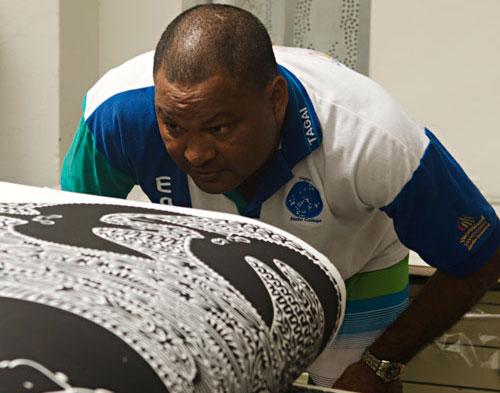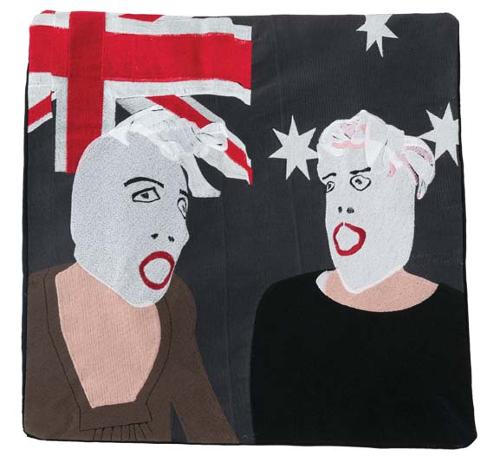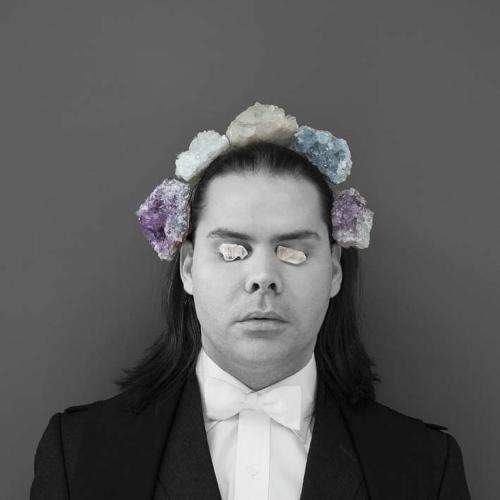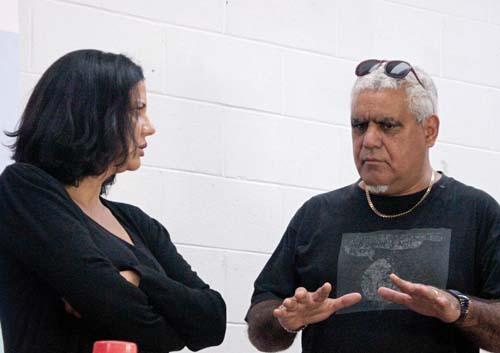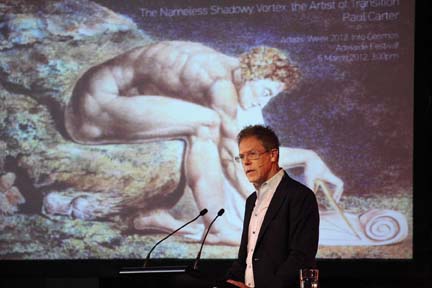
Artists' Week is a bit of a misnomer; Curators’ Week may be a better name for the four days of talks and audio-visual presentations that made up this part of the 2012 Adelaide Festival Visual Arts Program. International curators Hou Hanru, Cuauhtémoc Medina, Gerald McMaster, Jack Persekian and Jan Verwoert (the latter better known for his criticism) were the drawcards for the event.
It’s not that the program lacked artists or that they didn’t speak engagingly about their work --- but they weren’t as likely as the curators and academics to argue theoretical viewpoints and therefore be drawn into broader discussions. For instance, following a philosophy paper given by academic Jennifer McMahon, Danae Stratou began her talk with the wry observation, "I’m going to speak as an artist, of course... since I’m not a theorist". Artist Julie Rrap –ironically one of those artists who did participate in a lively theoretical conversation – was however reluctant to be pinned down on a question of theory put by a member of the audience. “I don’t really stand for one position… “, she said. “I like 'swimming around’ in theory.”
The title of Artists’ Week was Into Cosmos, with a focus on artists’ visions of the world around them as well as those worlds they create through their work. Cosmos is, of course, the Greek term for a system that is defined, orderly and harmonious, but the world under discussion was anything but. The most burning issue raised seemed to be whether, and how, artists might meaningfully engage with conditions of dislocation, exile, colonialism, instability, exploitation, globalisation and war. During his keynote closing address, academic Paul Carter asked the rhetorical question: “if we are moving ‘into cosmos’, where have we been hitherto?” One answer suggested by the content of many of the talks was: in its opposing condition – namely, chaos – and that heralding any departure from this state might be premature.
How is an artist to react to conditions of global trauma? Hou Hanru provided one response. Reading aloud the catalogue essay (already reprinted in Broadsheet) from the PhotoEspaña exhibition that he curated last year, he proposed that artists harness “the power of doubt”. Hanru identified photography and video as the most exemplary media for calling authoritative claims to truth into question because of the contradiction that they appear to provide a faithful representation of the real world while also being infused with subjectivity. By using photography and video to pull apart, or un-fix, “reducing images”, artists may “critically probe and reinterpret…issues of historicity and truth”.
The call for artists to engage with politics did not go unchallenged. An audience member asked artist NS Harsha why contemporary art from India seemed less likely to address political issues than that from China. His answer was that, “Most of the artists you hear [about] from China, they have this extreme presence on CNN and BBC. You can do the reverse as well! Why don’t you do the reverse from America to China?” He implied that Chinese artists were televised internationally only when they performed stunts or enacted roles conforming to Western media expectations, and that these communications flowed only in one direction. He further elaborated his position when he said “It is not a conscious duty for an artist to be a broadcast machine for social justice… I don’t think we are making illustrations of our times…“
Harsha’s viewpoint resonated with a dilemma identified by Jan Verwoert. Cuauhtémoc Medina had discussed a remark by artist Teresa Margolles that in the face of the Mexican drug war, it was unthinkable to make work about anything else; Verwoert responded that this very impossibility to entertain other subject matter may also entrap artists to fulfill the art world’s narrow demands. He said, “It’s not just about the frustration of artists to not be able to speak otherwise but of course, also, the offer of international careers that are possible when you join those narratives… Basically, you can shoot at the Separation Wall and you know that you have a ticket to international representation.”
The contribution of curator Jack Persekian may be considered in light of this dilemma; his subject was the Separation Wall that encloses Palestinian territories. Persekian gave his Adelaide audience the same performance, Nablus Soap, as he had previously delivered in Beirut, Abu Dhabi, Sydney, London, New York, Los Angeles and, in an earlier incarnation, at the World Economic Forum in Jordan. Its title and motif derive from a 1996 exhibition by Mona Hatoum at Persekian’s gallery in Jerusalem -– in which Hatoum used Nablus soap, a famous Palestinian product, to represent the instability of the borders produced by the Oslo Accords. Persekian’s performance was pitched as a work of art but it was also evidently an instance of political activism. In part a discussion of Hatoum’s 1996 work it was also, simultaneously, an appropriation of it.
Walls and borders snaked through several of the discussions on days two and three of Artists’ Week. The Separation Wall reappeared in Danae Stratou’s talk; images of it and other geopolitical divisions appear in her video The Globalising Wall which was included in the Adelaide Festival exhibition Restless. Some of the other ‘walls’ this work represents include the border between North and South Korea, and that between Mexico and the USA.
The latter division served as the framing device for Cuauhtémoc Medina’s talk. He introduced his presentation with an unusual ‘artwork’: the billboard erected by Mexican president Felipe Calderón near the border separating Mexico’s ‘deadliest city’ Ciudad Juárez, from El Paso in Texas. Written in English and saying NO MORE WEAPONS, the billboard seeks to persuade Americans to stop consuming drugs and selling illegal guns. Made of three tonnes of metal repurposed from seized illegal weaponry, Medina identified President Calderón’s offering as ushering in a new art genre: official post-conceptualism.
In discussing contemporary Mexican artists who explored themes including the drug wars, masculinity and social transformation, Medina attempted to answer the question: “what is the status of their works when the president of the nation – by the curator’s own account one of the principal authors of the drug war’s rapid escalation – engages in his own activist art making?”
From Medina’s presentation there emerged the most powerful image of Artists Week: a simple but unsettling piece of video footage by young Mexican artist, Edgardo Aragón, in which two boys ‘play’ at a drug-related murder in the front seat of an SUV. In Aragón’s video and in Medina’s talk, these few seconds of footage were looped over-and-over: a ritual execution in which one child killed the other endlessly.
Perhaps the best summary of Artists’ Week was that offered by Julie Rrap. Speaking on the last day, she observed: “Over the course of the four days, art has been pushed and pulled and expected to do many things and perform miracles in terms of its interface with the world, and the problems of the world.” Of course Artists’ Week couldn’t hope to solve the world’s problems, but it threw up some good questions and some productive disagreements too.


